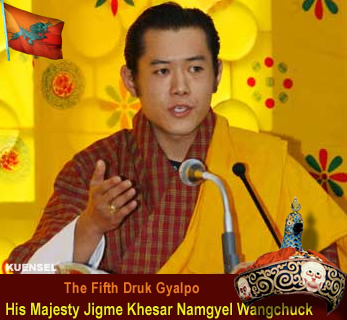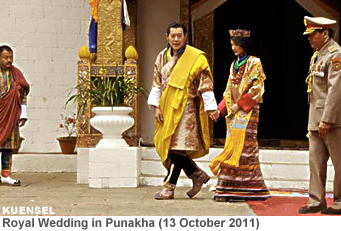 |
 |
Bhutan
Information |
|
 |
Bhutan
Information |
|
|
|
 |
|
Monarchy
and Government
|
 |
Prior
to the establishment of the monarchy, Bhutan followed a dual system of
administration initiated in 1652 by Zhabdrung Ngawang Namgyal. Under the
Chhoesi system, the Druk Desi looked after the temporal administration
and the Je Khenpo looked after religious matters of the country. Although
this form of government worked over two centuries, disputes over the succession
to the office brought about increasing strife and instability by the second
half of the 19th century.
 The
First and Second King of Bhutan The
First and Second King of Bhutan |
A
new era in the Bhutanese history began on the 17th December 1907,
when Trongsa Penlop (the Governor of Trongsa) Ugyen Wangchuck was
elected as the first hereditary king of Bhutan. It was a decision taken
unanimously by the clergy, officials, and people acting on their desire
for political stability and internal peace in the country. Thus, King Ugyen
Wangchuck laid the foundation for the emergence of modern Bhutan, uniting
it under a central authority.The
nation continued to enjoy peace and stability under the reign of the second
king Jigme Wangchuck who succeeded him in 1926 and ruled the country
till 1952.
 The
Third King - His Majesty Jigme Dorji Wangchuck The
Third King - His Majesty Jigme Dorji Wangchuck |
After
his ascension to the throne in 1952, the third king Jigme Dorji Wangchuck took the initiative of developing political consciousness among the Bhutanese
people by giving them a greater say in running the country. This was most
evident in the establishment if the National Assembly by the king in 1953,
and later still, when his majesty voluntarily surrendered the right to
veto bills in the Assembly. King Jigme Dorji Wangchuck also proposed a
mechanism of no-confidence vote that could require the king to abdicate
his throne if he was deemed unfit to rule the nation. This, however, was
met with a great deal of objection and resistance in the Assembly. Upon
yet another recommendation on this issue from the king in 1969, the Assembly
reluctantly approved the resolution whereby the reigning monarch would
have to abdicate if two-thirds of the Assembly supported a vote of no-confidence.
This system was however, abolished by the Assembly during the spring session
in 1973. Under the third king's reign, the Royal Advisory Council, the
Council of Ministers and Cabinet, and a High Court were also established.
Pertinently known as the father of modern Bhutan, king Jigme Dorji Wangchuck
was responsible for bringing planned development into the country with
the introduction of Five-Year Plans, shedding off centuries old isolation
and opening Bhutan up to the rest of the world. In 1971, Bhutan joined
the United Nations Organization.
 The
Fourth King - His Majesty Jigme Singye Wangchuck The
Fourth King - His Majesty Jigme Singye Wangchuck |
King Jigme
Singye Wangchuck ascended the throne in 1972. Like his father before
him, the young king at the age of 17 wanted to open and modernize the country
in a cautious manner and has always stressed on the need to foster a balanced
society by promoting tradition, culture and the preservation of the environment.
Considered a people's monarch in every sense, His Majesty has guided the
nation towards the pursuit of economic self-reliance, cultural promotion,
environmental preservation, regionally balanced development, good governance
and decentralization.
Following
the royal decree issued by the king in September 2001, the government of
Bhutan inaugurated the drafting of a Constitution, which is widely seen
as a historic move in the process of political evolution initiated by His
Majesty. The process of decentralization was a personal initiative of the
king with the introduction of Dzongkhag Yargye Tshogchungs (DYTs) in 1981,
and Geog Yargye Tshogchungs (GYTs) in 1991. Emotions ran high among the
Bhutanese people when His Majesty devolved all executive authority from
the throne to the cabinet in 1998 introducing a system in which the National
Assembly would elect a Council of Ministers by secret ballot, and direct
the National Assembly to re-introduce the system of a vote of confidence
in the King.
 The
Fifth King - His Majesty Jigme Khesar Namgyel Wangchuck The
Fifth King - His Majesty Jigme Khesar Namgyel Wangchuck |
 |
| the 5th Druk Gyalpo, HM Jigme Khesar Namgyel Wangchuck |
| His
Majesty Jigme Khesar Namgyel Wangchuck is the fifth Druk Gyalpo.
The fourth Druk Gyalpo, His Majesty Jigme Singye Wangchuck, has handed
over his responsibilities as the Monarch and head of state of Bhutan to
the Crown Prince Jigme Khesar Namgyel Wangchuck who now assumes
the full responsibilities of head of state as the fifth Druk Gyalpo.
As
the transition was formally announced on December 14, 2006,
the 24th day of the 10th Bhutanese month. |
|
His
Majesty Jigme Khesar Namgyel Wangchuck was born on February 21,
1980. After completing early schooling in Bhutan, His Royal Highness completed
high school and graduated from the Cushing Academy and the Wheaton College,
USA.
In
2000, His Majesty continued further ducation in Magdalen College, Oxford
University. His Majesty completed the Foreign Service Programme and a M
Phil programme in Politics at Oxford University.
|
Royal Wedding -Jetsun Pema as the Druk Gyal-tsuen (Queen of Bhutan)
|

|

|
| The youngest reigning monarch of the world's youngest democracy, His Majesty Jigme Khesar Namgyel Wangchuck, 31, will wed Jetsun Pema, 21, in a rich and solemn traditional religious ceremony fulfilling the wishes of the Bhutanese people in the Punakha Dzong that sits where the Pho Chu and Mo Chu rivers meet.
The sacred nuptial ceremony, which starts as early as four in the morning, will also proclaim royal bride Jetsun Pema as the Druk Gyal-tsuen (Queen of Bhutan).
|
|
 Government Government |
Governance
in Bhutan concerns the efforts of the National Assembly, Judiciary, Council
of Ministers, Royal Advisory Council, and the Central Government.
 National
Assembly National
Assembly |
Set
up in 1953, the Tshogdu (National Assembly) meets twice in a year
and can be called for emergency sessions. Of its 150 members, 99 are chimmis
or representatives of the people. The Monk Bodies elect 10 representatives
for the monastic community. The remaining 35 are representatives of the
Government and nominated from among senior officials by the king. The assembly
from amongst its members elects the Speaker and Deputy Speaker. All members
serve for a term of three years.
|





